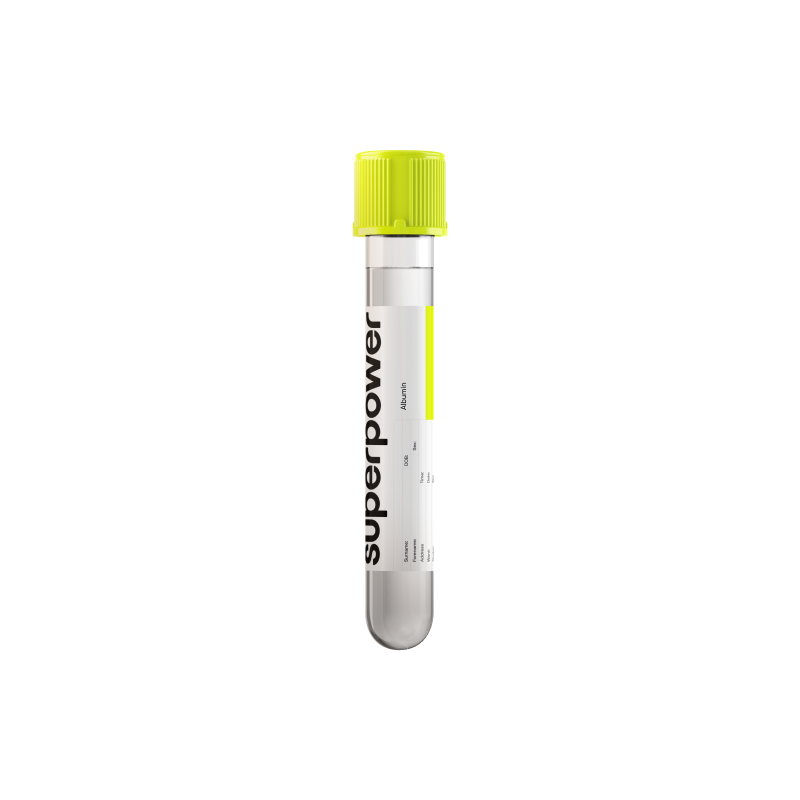Albumin testing provides a window into recovery, resilience, and whole-body health. It helps detect undernutrition, liver strain, protein loss, or dehydration, while also guiding smarter choices in diet, hydration, alcohol use, and training recovery.
Key Benefits
- Check your blood's main protein to reflect liver function and overall health.
- Spot systemic inflammation or illness when albumin drops; detect dehydration when it rises.
- Clarify leg swelling, abdominal fluid buildup, or fatigue by linking to protein loss.
- Flag kidney protein loss or reduced liver production before complications develop.
- Guide nutrition support in chronic illness and protein-bound medicine dosing when levels are low.
- Support pregnancy monitoring by recognizing expected dilutional drops versus disease-related declines.
- Track chronic liver, kidney, or inflammatory conditions and recovery across time.
- Best interpreted with liver enzymes, kidney tests, urine protein, and your symptoms.
What is Albumin?
Albumin is the body’s most abundant blood protein, made almost entirely by the liver (hepatocytes) and released into the bloodstream (plasma). It is a compact, water‑soluble molecule with many binding pockets, designed to travel widely in the circulation and the fluid between tissues (interstitial fluid). After it is made, albumin circulates throughout the body and is conserved by the kidneys, which filter it and reclaim it under normal conditions. Because it is so plentiful, albumin is a central component of plasma.
Albumin’s primary job is to hold water inside blood vessels by generating the protein-based pull that counterbalances leakage (colloid osmotic pressure, also called oncotic pressure). It also works as a versatile carrier (transport protein), binding and shuttling hormones, fatty acids, bilirubin, metals, and many drugs, shaping their distribution and availability (bioavailability). In addition, albumin helps buffer acid–base shifts and scavenges reactive molecules (antioxidant activity). Through these roles, albumin supports stable circulation, nutrient delivery, and chemical balance across tissues.
Why is Albumin important?
Albumin is the liver’s main circulating protein that keeps fluid inside blood vessels and ferries many molecules—hormones, fatty acids, bilirubin, calcium, and drugs—through the bloodstream. By maintaining oncotic pressure, buffering acids, and binding toxins and oxidants, it supports stable circulation, tissue nourishment, and predictable drug effects across body systems.
Most labs define a general reference range around the mid-3s to about 5. Values near the middle tend to signal steady liver synthesis, balanced hydration, and less systemic inflammation.
When albumin runs low, it usually reflects reduced production (liver disease), increased loss (kidney urine loss or gut protein loss), dilution (heart failure or expanded plasma volume), or inflammation, where albumin drops as a negative acute-phase reactant. The physiologic result is less oncotic pull: ankles swell, ascites may appear, lungs can feel heavy, and wounds heal slowly. Drug binding falls, raising free drug levels, and total calcium may look low because less is carried on albumin. Pregnancy commonly shows lower values from hemodilution; infants can be slightly lower; older adults with low albumin often exhibit frailty and higher illness risk. Men and women have similar ranges.
Higher albumin is uncommon from overproduction; it most often signals hemoconcentration from dehydration. People may notice thirst, dizziness, or rapid pulse; total calcium can appear high simply from increased protein binding.
Big picture, albumin integrates liver function, vascular integrity, kidney and gut losses, hydration, and inflammation. Persistently low levels track with higher risks in surgery, hospitalization, and chronic disease, making albumin a powerful window into whole-body resilience and long-term outcomes.
What Insights Will I Get?
What albumin tells you
Albumin is the main protein made by the liver that keeps fluid inside blood vessels (oncotic pressure) and carries hormones, fatty acids, bilirubin, calcium, and many drugs. It integrates liver synthetic capacity, hydration status, and inflammatory load, so it touches energy delivery, vascular stability, kidney filtration, wound repair, and overall resilience.
Low values usually reflect reduced production or dilution, or excess loss. Common drivers are active inflammation (albumin is a negative acute‑phase reactant), liver dysfunction, overhydration, kidney loss in urine (nephrotic syndrome), gut loss (protein‑losing enteropathy), or burns. System‑level effects include tissue swelling (edema/ascites), lower effective blood volume, impaired transport of hormones and medications, and higher risk during illness. Levels tend to run lower in older adults and during pregnancy due to plasma volume expansion.
Being in range suggests adequate liver synthesis, stable intravascular volume, and a relatively low inflammatory burden, supporting steady hemodynamics, drug binding, antioxidant capacity, and effective healing. Within the reference interval, mid‑to‑high normal is often associated with better clinical robustness in population studies.
High values usually reflect hemoconcentration from reduced plasma volume (dehydration) or prolonged tourniquet use at blood draw. True overproduction is rare. Systemically, it signals low circulating volume and can make other blood tests appear “high” by concentration rather than true increase.
Notes: Acute illness, surgery, and trauma can lower albumin independent of nutrition by shifting hepatic protein priorities. Intravenous fluids dilute it; intravenous albumin raises it transiently. Reference ranges differ for children and are lower in pregnancy. Some medications and estrogen‑related plasma volume changes can modestly affect levels. Assay methods and posture at draw introduce small variability.



.svg)



.png)
.png)
.png)
.png)








